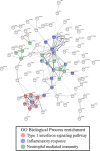A blood RNA transcript signature for TB exposure in household contacts
- PMID: 32517725
- PMCID: PMC7282166
- DOI: 10.1186/s12879-020-05116-1
A blood RNA transcript signature for TB exposure in household contacts
Abstract
Background: Current tools for diagnosing latent TB infection (LTBI) detect immunological memory of past exposure but are unable to determine whether exposure is recent. We sought to identify a whole-blood transcriptome signature of recent TB exposure.
Methods: We studied household contacts of TB patients; healthy volunteers without recent history of TB exposure; and patients with active TB. We performed whole-blood RNA sequencing (in all), an interferon gamma release assay (IGRA; in contacts and healthy controls) and PET/MRI lung scans (in contacts only). We evaluated differentially-expressed genes in household contacts (log2 fold change ≥1 versus healthy controls; false-discovery rate < 0.05); compared these to differentially-expressed genes seen in the active TB group; and assessed the association of a composite gene expression score to independent exposure/treatment/immunological variables.
Results: There were 186 differentially-expressed genes in household contacts (n = 26, age 22-66, 46% male) compared with healthy controls (n = 5, age 29-38, 100% male). Of these genes, 141 (76%) were also differentially expressed in active TB (n = 14, age 27-69, 71% male). The exposure signature included genes from inflammatory response, type I interferon signalling and neutrophil-mediated immunity pathways; and genes such as BATF2 and SCARF1 known to be associated with incipient TB. The composite gene-expression score was higher in IGRA-positive contacts (P = 0.04) but not related to time from exposure, isoniazid prophylaxis, or abnormalities on PET/MRI (all P > 0.19).
Conclusions: Transcriptomics can detect TB exposure and, with further development, may be an approach of value for epidemiological research and targeting public health interventions.
Keywords: Biomarkers; TB exposure; TB infection; RNA sequencing; Tuberculosis; gene expression; Whole blood.
Conflict of interest statement
The authors report no conflict of interest.
Figures

References
-
- Getahun H, Matteelli A, Chaisson RE, Raviglione M. Latent mycobacterium tuberculosis infection. N Engl J Med. 2015;372(22):2127–2135. - PubMed
-
- Cobelens F, Kik S, Esmail H, Cirillo DM, Lienhardt C, Matteelli A. From latent to patent: rethinking prediction of tuberculosis. Lancet Respir Med. 2017;5(4):243–244. - PubMed
-
- Paton NI, Borand L, Benedicto J, Kyi MM, Mahmud AM, Norazmi MN, Sharma N, Chuchottaworn C, Huang Y-W, Kaswandani N. Diagnosis and management of latent tuberculosis infection in Asia: review of current status and challenges. Int J Infect Dis. 2019;87:21–29. - PubMed
-
- Yap P, Tan KHX, Lim WY, Barkham T, Tan LWL, Mark I, Chen C, Wang YT, Chee CBE. Prevalence of and risk factors associated with latent tuberculosis in Singapore: a cross-sectional survey. Int J Infect Dis. 2018;72:55–62. - PubMed
MeSH terms
Substances
Grants and funding
LinkOut - more resources
Full Text Sources
Miscellaneous

